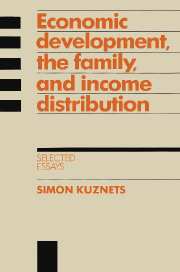Book contents
- Frontmatter
- Contents
- Preface by Louis Galambos and Robert Gallman
- Foreword by Richard A. Easterlin
- 1 Driving forces of economic growth: what can we learn from history?
- 2 A note on production structure and aggregate growth
- 3 The pattern of shift of labor force from agriculture, 1950–70
- 4 Modern economic growth and the less developed countries
- 5 Notes on demographic change
- 6 Recent population trends in less developed countries and implications for internal income inequality
- 7 Demographic aspects of the size distribution of income: an exploratory essay
- 8 Size and age structure of family households: exploratory comparisons
- 9 Size of households and income disparities
- 10 Distributions of households by size: differences and trends
- 11 Children and adults in the income distribution
- Afterword: Some notes on the scientific methods of Simon Kuznets by Robert William Fogel
- Bibliography of Simon Kuznets
- Index
Foreword by Richard A. Easterlin
Published online by Cambridge University Press: 12 November 2009
- Frontmatter
- Contents
- Preface by Louis Galambos and Robert Gallman
- Foreword by Richard A. Easterlin
- 1 Driving forces of economic growth: what can we learn from history?
- 2 A note on production structure and aggregate growth
- 3 The pattern of shift of labor force from agriculture, 1950–70
- 4 Modern economic growth and the less developed countries
- 5 Notes on demographic change
- 6 Recent population trends in less developed countries and implications for internal income inequality
- 7 Demographic aspects of the size distribution of income: an exploratory essay
- 8 Size and age structure of family households: exploratory comparisons
- 9 Size of households and income disparities
- 10 Distributions of households by size: differences and trends
- 11 Children and adults in the income distribution
- Afterword: Some notes on the scientific methods of Simon Kuznets by Robert William Fogel
- Bibliography of Simon Kuznets
- Index
Summary
Simon Kuznets's scholarly work spans over half a century and includes over twenty books and several hundred articles. In terms of sheer volume it is a prodigious individual record; by any quality-adjusted measure, it is awe-inspiring. The present collection of essays and research articles, done by Kuznets when he was in his seventies and now assembled and published posthumously, helps round out the record of this remarkable scholar and individual. The volume is not a “capstone”, for Kuznets's systematic search for new knowledge was never-ending. It represents, rather, the concerns at the top of his research agenda at a late phase of his career, plus several articles expounding on themes from earlier work.
The first four chapters fall in the category of expounding on earlier themes. They deal with the economic epoch that Kuznets, more than any other individual, has identified and analyzed, “modern economic growth”. It was for his empirically founded cross-national study of this epoch that Kuznets was awarded the 1971 Nobel prize in economics. In the first four chapters of this volume he returns to the subject, developing new insights and elaborating old. Chapters 1 and 4 deal in somewhat different fashion with what Kuznets calls the “driving forces” of economic growth. In these two chapters Kuznets departs from his usual insistence on measurement – the reader will note the absence of the usual statistical tables – to speculate on causation.
- Type
- Chapter
- Information
- Economic Development, the Family, and Income DistributionSelected Essays, pp. 1 - 6Publisher: Cambridge University PressPrint publication year: 1989

